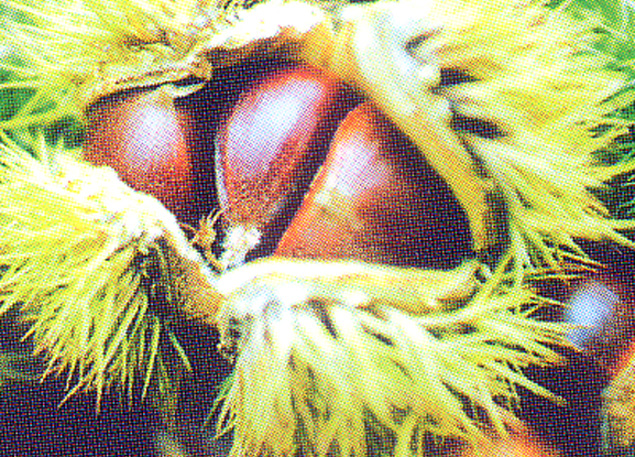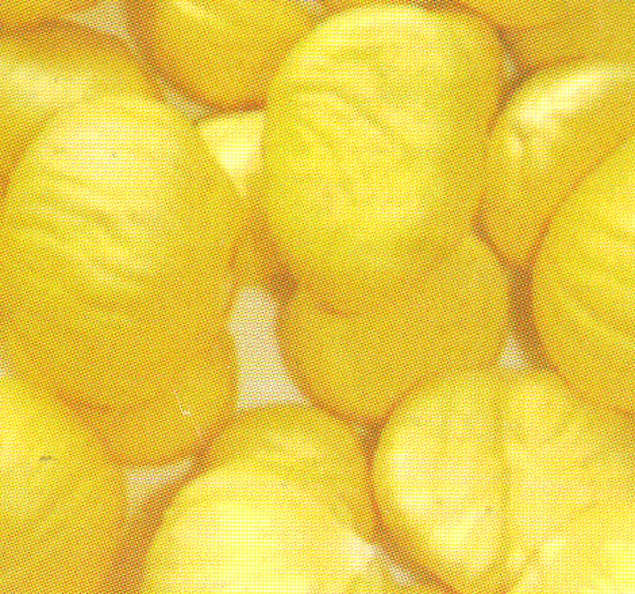
| What is Flavor and Fortune? |
| How do I subscribe? |
| How do I get past issues? |
| How do I advertise? |
| How do I contact the editor? |
Read 12932793 times
Connect me to:
| Home |
| Articles |
| Book reviews |
| Letters to the Editor |
| Newmans News and Notes |
| Recipes |
| Restaurant reviews |
| Article Index (all years, slow) |
| List of Article Years |
| Article Index (2025) |
| Article Index (last 2 years) |
| Things others say |
| Related Links |
| Log In... |
| Authors |
| Categories & Topics |
Chinese Chestnuts
| by Jacqueline M. Newman |
Vegetables and Vegetarian Foods
Winter Volume: 2008 Issue: 15(4) page(s): 32 and 34
In pre-Qin Dynasty writings, that is before 221 BCE, Chinese chestnuts were frequently used; and some time thereafter, they were written about. From trees indigenous to the temperate zones of North China, along with peaches, plums, and Chinese dates, chestnuts were mentioned as ceremonial offerings. What type of chestnuts? Good question, as there are many varieties. In ancient writings, no particular one was specified, but one variety, Castanea sativa, was found in Han dynasty tombs.
 The common Chinese chestnut is a member of the Fagaceae more commonly called: The Beech family. Chestnuts grow on very tall deciduous trees that bear tooth-edged leaves and male and female flowers. The flowers bear the fruit, and they appear in spiny husks. Pictured on this page, the husks spilt open when ripe. Inside are three large brown chestnuts. Other varieties now found throughout China and elsewhere in Southeast Asia are the Japanese chestnut, Castanea crenata and two American chestnuts, the Castanea dentata and the Castanea pumila. These are newer varieties to China.
The common Chinese chestnut is a member of the Fagaceae more commonly called: The Beech family. Chestnuts grow on very tall deciduous trees that bear tooth-edged leaves and male and female flowers. The flowers bear the fruit, and they appear in spiny husks. Pictured on this page, the husks spilt open when ripe. Inside are three large brown chestnuts. Other varieties now found throughout China and elsewhere in Southeast Asia are the Japanese chestnut, Castanea crenata and two American chestnuts, the Castanea dentata and the Castanea pumila. These are newer varieties to China.
Chinese chestnuts, Castanea mollissima, are one of many known varieties with a long history as food for human consumption. One sees them and all kinds of other chestnuts heated and roasted on street corners in many cities in many countries. This means of selling this street food is believed to have been something done in earlier times in China and elsewhere.
In the past in China, chestnuts were cooked and preserved, usually whole and in honey. They were also boiled or braised alone or with other foods, and dried, reconstituted, and then cooked later. Dried chestnuts were also ground into flour for use in bakery products and in desserts. A modern treatment is to freeze them unsweetened; another is to cook and package them, a few to a small sealed multi-layered plastic and foil container.
The Chinese chestnut was resistant to the blight that killed thousands of Chestnut trees in Europe. Therefore, their offspring are popular and seen everywhere these days. They are soft-textured with smooth hard shiny shells. Fresh trios of chestnuts are removed from their husks and then from their shells, their inner thin skins then removed, before they are packaged or eaten. Boiling or soaking them facilitates this otherwise laborious process; and though the ones in retort packages are not as good as fresh ones, they surely are popular.
Known as li zi, chestnuts have an irresistible aroma when that are roasting, especially when in cold fall or winter weather when encountered on street corners. The ones seen in China fresh or in packages were harvested in the wild on hillsides near the Yangtzi River in Central China or harvested from tracts where they are grown commercially.
 Commercial growers do pack their peeled ones in the previously mentioned plastic and metal retort packages, also sell them fresh, and they sell them loose and in plastic bags. Packaged ones are easier to use and the reason why there are increased sales and consumption these days. When buying yours this way, press the packet to see that its contents are firm. When buying them fresh, do likewise with each fresh chestnut. Once opening any chestnut, be sure that it does not smell musty; and if it does, discard it.
Commercial growers do pack their peeled ones in the previously mentioned plastic and metal retort packages, also sell them fresh, and they sell them loose and in plastic bags. Packaged ones are easier to use and the reason why there are increased sales and consumption these days. When buying yours this way, press the packet to see that its contents are firm. When buying them fresh, do likewise with each fresh chestnut. Once opening any chestnut, be sure that it does not smell musty; and if it does, discard it.
To cook raw chestnuts in their hard shells, cut an 'X' in the flat side of that shiny shell, then boil them for half an hour. Remove just a few from the boiling water and peel away the outer shell and the thin inner skin. Repeat, only peeling a few at a time when they are as hot as can be handled. Chestnuts do not peel easily when cool.
Good chestnuts are white inside with no sign of mold or any black or dark brown areas. Keep fresh chestnuts in a cool place or in the refrigerator until you are ready to cook them. Be sure not to purchase horse chestnuts; they are not related to the true chestnut, their contents are very bitter as they have a high tannin content. They are not intended for human consumption.
The Chinese use edible chestnuts in many ways, fresh or dried; and as a flour. Traditional Chinese medicine practitioners believe them an effective treatment for diarrhea as they firm the stool. They also recommend them to strengthen the kidneys and as an item to treat abnormal bouts of hunger. They advise that chewing just three of them can stop a sudden hunger attack instantly. Traditional Chinese medicine practitioners report that chestnuts are sweet and warm by nature, that they nourish the intestines, invigorate qi, and strengthen the spleen. They warn not to eat too many at any one time because doing so can cause indigestion.
Here are but a few Chinese recipes to illustrate using them in different ways. Chinese cookbooks have dozens and dozens more; they are a popular casserole and dessert ingredient.
| Chicken Wings and Chestnuts |
|---|
1 pound chestnuts, boiled for ten minutes, then peeled 1 pound chicken wings, tips discarded, then each one chopped into four pieces 1/4 cup chestnut flour 2 Tablespoons all-purpose flour 1 Tablespoons Shaoxing wine 1 Tablespoons cornstarch 2 Tablespoons vegetable oil 3 slices fresh ginger, peeled and minced 10 dried Chinese black mushrooms, soaked, stems discarded, the each one cut in half 2 Tablespoons oyster sauce 1 Tablespoon dark soy sauce Preparation: 1. Put chestnuts and chicken wing pieces in a large bowl. Add chestnut flour and all-purpose flour and mix well. Set aside for half an hour until the flours are no longer dry. 2. Then add the wine and the cornstarch and stir well. 3. Heat wok of fry pan, add the oil, and after half minute, add the ginger and the chestnut and chicken pieces, and stir-fry for two minutes. Then add the mushrooms, and stir-fry another minute. Add two cups of boiled water, and the oyster and soy sauces. Simmer just below the boiling point for forty minutes; and do add water, half cup at a time if the sauce boils dry. Then transfer everything to a pre-heated casserole and serve. |
| Peking Dust |
|---|
1 pound fresh chestnuts 10 ounces very cold evaporated whole milk or cream 4 Tablespoons superfine sugar 10 glazed chestnuts Preparation: 1. Make slits or cut an 'X' through the skin on the flat side of each chestnut. Then boil them for half an hour, and turn off the heat under their pot. Remove three to five of them from the hot water, and remove their shells and their inner skins. Discard these and take another small number out of the hot water and repeat the process. Continue until all shells and peels are removed. 2. Allow the chestnuts to cool somewhat, then mash them well or put though a coarse strainer. Using a fork or spoon, gently mix this chestnut material so it stays light and is somewhat granular. 3. Whip the evaporated milk or the cream with the sugar until stiff. Put it into ten small chilled bowls. 4. Using a spoon or a fork, heap one tenth of the chestnut ‘dust’ over the cream and top each dish of the dessert mixture with a glazed chestnut. Then serve. |
| Spareribs with Chestnuts |
|---|
4 ounces whole dried chestnuts, soaked overnight in boiling water; then drained 2 pounds pork ribs cut into two-inch pieces then separated into individual riblets 1 Tablespoon vegetable oil 2 cloves fresh garlic, peeled and minced 1 Tablespoon granulated sugar 2 Tablespoons cornstarch Preparation: 1. Simmer chestnuts for thirty minutes in two cups of water. Drain and retain and chill the water. 2. Mix cut spareribs, garlic, and sugar, and mix with the meat. Let stay covered well and in the refrigerator for one hour, then take out and let sit at room temperature for half an hour. 3. Heat wok or deep fry pan and add the oil, then the spareribs and fry them until they are well-browned. 4. Bring one cup of the cold chestnut water to the boil and mix two tablespoons of the cold chestnut water with the cornstarch and set this aside. 5. Add the chestnuts to the boiling chestnut water, add the spareribs and reduce heat, simmering this for one hour. 6. Stir the cornstarch mixture, and add it to the sparerib mixture, and stir until it thickens, then put into a bowl and serve. |

Copyright © 1994-2025 by ISACC, all rights reserved
Address
3 Jefferson Ferry Drive
S. Setauket NY 11720